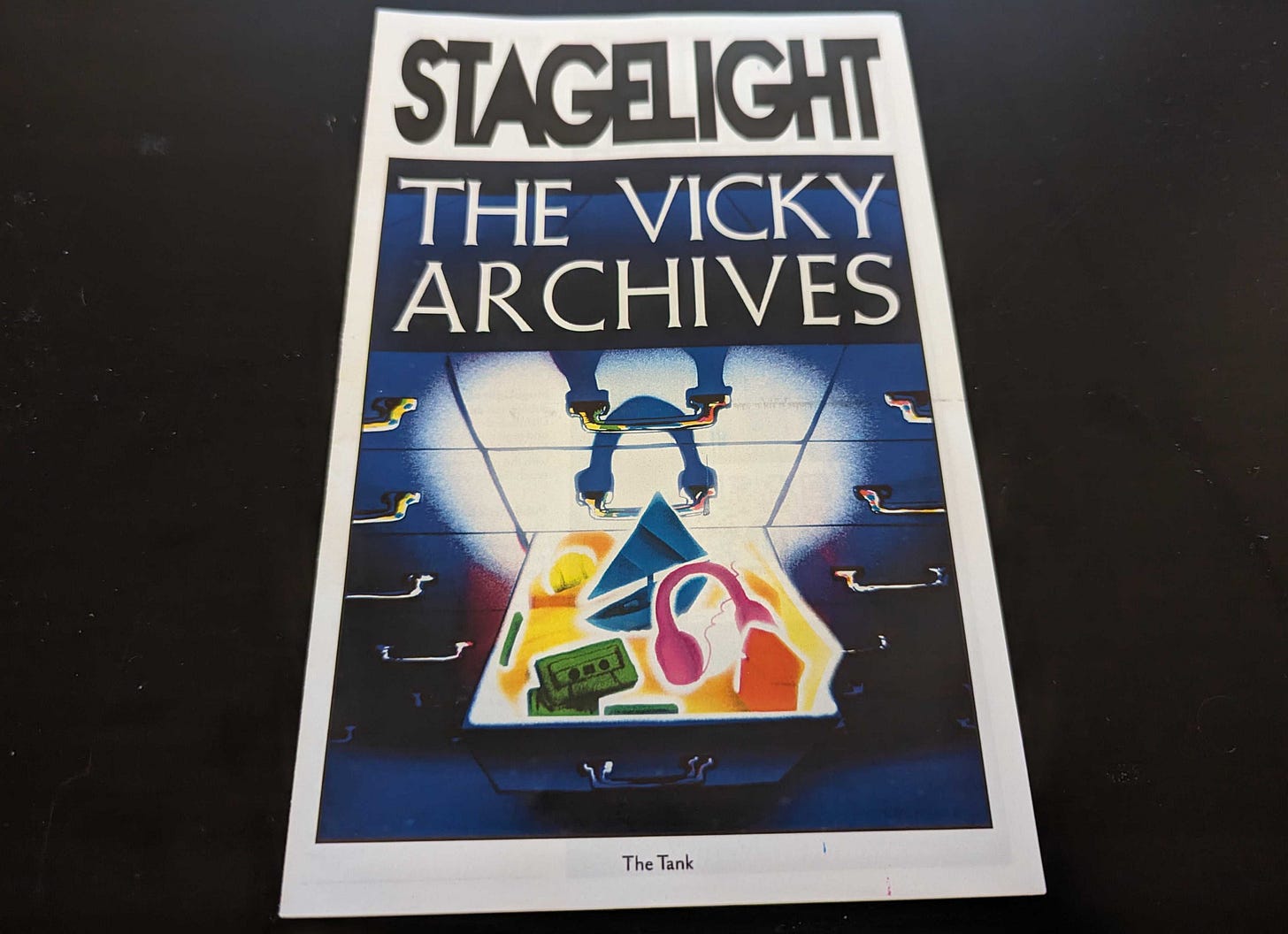The Power of Asking Less of Your Audience: The Vicky Archives
Sometimes, casting the audience in a simpler role makes for a stronger experience

Disclaimer: This review goes into greater depth about the narrative of The Vicky Archives than I would normally provide. However, the show’s final performance was last night, and the elements discussed should not ruin the experience if it eventually gets remounted.
Last week, I took a trip to visit The Vicky Archives as they prepared a collective of four troubled souls to share the breadth of their lives through an intensive 11 day recording process. The archive was founded by a man named Harold, who recorded Vicky’s own life over a similar time frame. After completing her own narrative, she was left feeling empty…drained…but in that state, she achieved a form of enlightenment, and went on to live a happy life in Nebraska. The four acolytes we witnessed were part of the 37th cohort to go through the process, overseen by Harold’s son (conveniently also named Harold), taking over the family legacy.
That was the narrative framing for The Vicky Archives, an immersive theater production put on by the Brouhaha Theatre Project in the sixth floor attic space of The Tank. To use No Proscenium’s immersive nomenclature, The Vicky Archives was a “Dark Ride” experience. Players are guided from location to location on frequently divergent paths by its creators, creating a curated path through the work.

The Narrative Flow of The Vicky Archives
After admission into the venue, audience members are led to a concessions area to mingle prior to the beginning of the night’s festivities. A few times during this informal meet-and-greet, groups of attendees are called by name and guided to another room (more on that later).
Finally, the show is ready to begin in earnest: Harold (the younger) introduces The Vicky Institute’s work to the full audience, and guides them into a room ringed by a circle of chairs to meet the four souls preparing for their sessions. Nametags with our first name and last initial are helpfully placed on each chair, to let us know exactly where to sit.
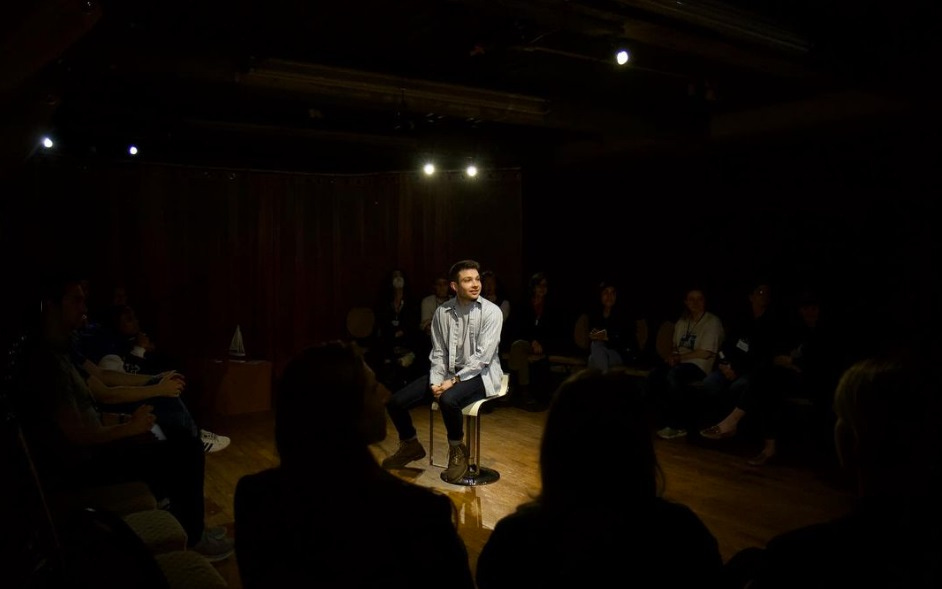
The four figures introduce their stories, and we learn that the process of preparing one’s life story for an 11-day retelling is quite an involved process, requiring both introspection and self awareness. To demonstrate this process, two of them play a game of radical honesty that’s a heartbreakingly cruel exchange of “truths” before demonstrating that it’s alright by hugging it out, faces beaming with smiles. It’s not alright. One of the acolytes named Falcon workshops a story from his childhood. He is frequently interrupted by his fellow storytellers with deeply probing questions, trying to dissect not just what he remembers, but why. It is helpful. It is also deeply manipulative. All along, a woman named Jo silently takes notes on the whiteboard in the background.
At this point, we are broken into groups, with characters approaching groups of audience members and guiding them to their next destination within the attic. I am ultimately guided by Jo to the Archives room itself, where Vicky’s tapes are kept. This is where select audience members were guided prior to the show’s official start. We are reverently presented with artifacts from prior Archives, before a cassette tape is pulled out and we are treated with an excerpt from Vicky’s own life. It’s time to move on, now.
Kaylee’s Story: Clinging to Something of Her Own
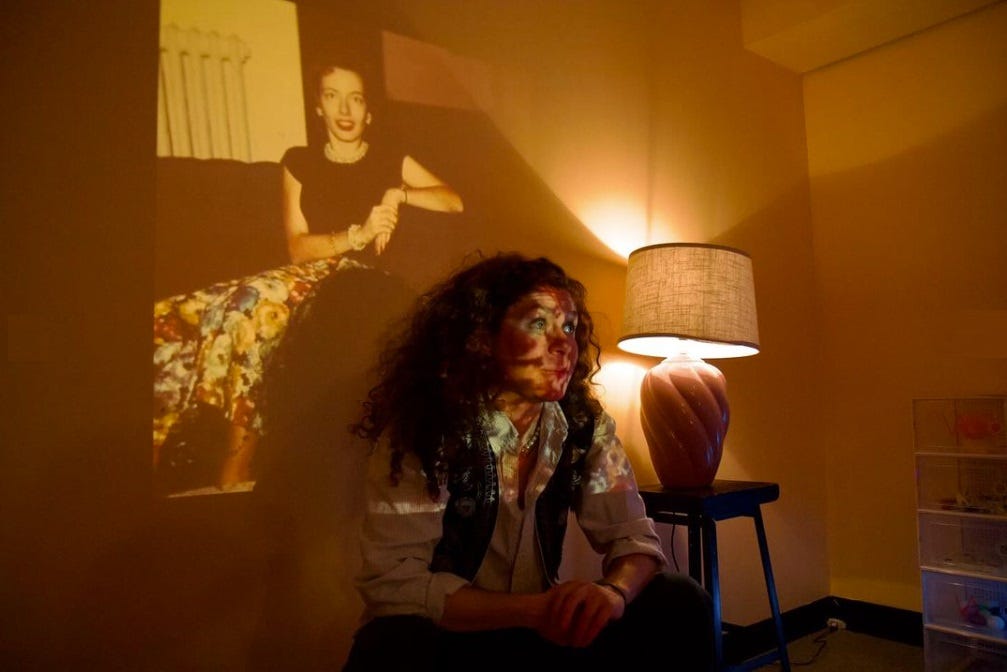
The four of us are guided to a sensory room, where Kaylee walks us through a slideshow from her childhood. I’m handed a clicker for the carousel, and instructed to press the button every time she says “Next”. Many of the slides are unfamiliar even to Kaylee, and we move on past. But not this one. Not the photograph of Aunt Ida. Here, we linger and Kaylee shares a deeply personal moment about how much she admired Ida: how even at her lowest, the thought of Ida bouyed her. She begs us: her memory of Aunt Ida is special: can we keep it a secret from Harold? Can she have just one moment - this moment, for herself?
We agree. But then…things start going wrong. We see both characters and audience members rushing through the halls. Another group of audience members are brought into our room in the hustle and bustle, and now we’re a larger assemblage. They must have heard Kaylee’s story earlier. Through the chaos, a slide flits by: Kaylee is keeping secrets.
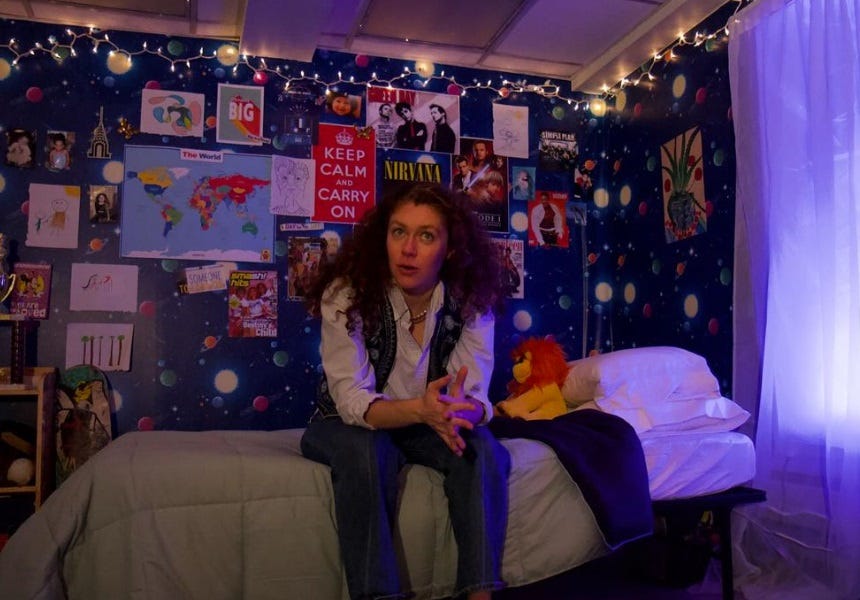
Things calm down, and Harold guides us to a room that replicates Kaylee’s childhood bedroom, where he confronts her. Kaylee’s been holding back, hasn’t she? She prevaricates. She just wants to spend the final night before her Archival here, in this facsimile of her childhood room. There’s nothing else.
We are silent.
After Kaylee lulls herself to sleep, the door opens. Someone enters. That someone is wearing Aunt Ida’s dress, from the slideshow. They’re wearing a wig, to look even more like Ida. That someone is Harold. He wakes Kaylee up, and talks to her about “Ida’s” life, manipulating her back on track to the story they all agreed she would tell. Even Aunt Ida wasn’t a secret from the Archives. He lulls Kaylee back to sleep, with her head nestled in his lap, and leaves…but not before taking off his wig, and looking us in the eyes. Did he say “you shouldn’t have seen that?” I don’t recall whether it was a mournful admission, or threat.
We are still silent.
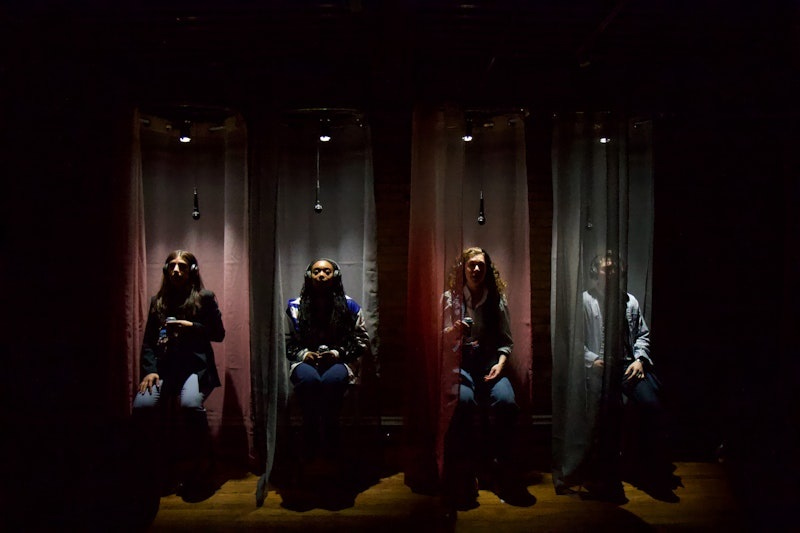
Finally, we’re hustled off to the start of the 37th batch of Vicky Archive recordings. Falcon and Howard share a brief argument off-stage: he’s worried about Sandy. He’s not sure she’s ready. My path didn’t cross theirs, so I’m missing some of the finer details, but the finale fills in the blanks. We learn that while Vicky’s own path through the process led to enlightenment, her experience is not universal. The show goes on. We remain silent. And we become partially complicit, through that silence.
I’ve revealed more than enough with the above overview…the exact details of the end, however, I plan on saving for myself, and for fellow attendees who experienced it themselves. It doesn’t change what I’m about to discuss that made the show so magical for me.
The Illusion of Agency Can Be More Powerful Than “Meaningful” Participation
I started off this piece mentioning that The Vicky Archives was a “dark ride” immersive, where the creators guided us through every step of the process. This became evident very early on: prior to the show’s official start, audience members were called to visit the Archives room explicitly, by name. When we were led to the initial circle, nametags were placed on the chairs to provide us with assigned seats, so that our very physical location would slot us into our prescribed paths for the evening.
This wasn’t a fully passive experience. Things were asked of us, but in a highly prescriptive fashion. Read the paper. Click the slides to advance. Answer a simple question. The experience trained us to listen and comply to direct requests, and remain silent but present for the rest.
Kaylee’s path in particular twisted that framework, to train us into complicity. She actually did present us with a meaningful request…to refrain from taking action. “Please don’t tell him.” So we remained silent. But then, Howard came to us as Aunt Ida, and manipulated someone we’d grown to trust. And maybe, in a different kind of show, one of us might have tried to warn Kaylee, before moving on. But we didn’t. We let her believe.
The finale doubles down on this theme, reminding us that we came to The Vicky Archives as an audience, to consume their stories. And that process of consumption came at a cost that could have been prevented. The structure of the play was designed to make that all but impossible…but the small moments where we did get involved along the way nonetheless made us feel more involved in the result than we should have, had we just been an audience.
There were numerous spaces throughout the show where The Vicky Archives could have asked more of its audience. We could have been asked to give of ourselves, and share personal traumas. We could have been asked for guidance as the characters grappled with their struggles and doubts and insecurities. But ultimately, while those moments might have added immersion in the moment, it likely would have cheapened both the show and its message.
On the Nature of Memory and The Vicky Archives
The Vicky Archives is a show about memories…not just the details of what you remember, but also about what you share, and who you share it with. And it’s due in part to grappling with these themes that I’ve “spoiled” so much of an immersive theater performance, even if it did have its final curtain call.
For a show about creating a lasting archive of someone’s story, I find it utterly fascinating that the character roles themselves are so thoroughly suppressed - seemingly, intentionally show. The cast page on The Vicky Archives program lists the cast and crew…but it doesn’t connect them to their roles. The Brouhaha Theatre website is similarly silent.
This article guesses at the spelling of names like Kaylee and Jo, because I can’t find a written record that those characters ever even existed outside the walls of the theater (as scrawled writings in Kaylee’s erstatz bedroom shared notes about the characters). I only have my memory. And while I remember Falcon and Sandy’s names thanks to some of the events from the finale, I couldn’t tell you the name of the character played by Nile Assata Harris.
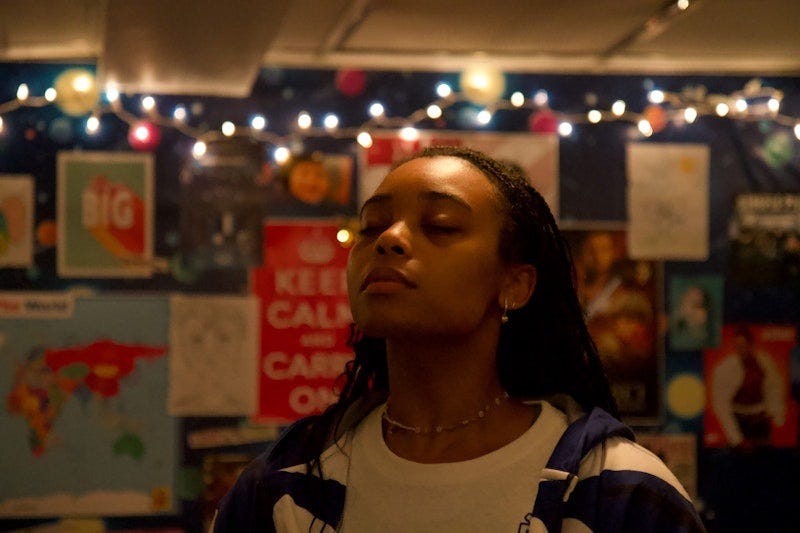
Our paths didn’t overlap after the introductory scenes, so all I know is that she grew up rich, and found a weird kind of meaning once she discovered joy as a social media influencer who specializes in deep-cleaning carpets on TikTok. Her name was shared a few times…but without enough repetition, it wasn’t one of the details that stuck with me.
On a meta-level, Harold’s character seemed aware of that danger on a level that none of the other characters quite grasped, and he relished in reminding us of his name, as well as his father’s. Declarative statements that his name was Harold and that his father’s name was also Harold came frequently enough that each new instance of him chewing through his name were met with laughter from the audience.
And yet, we all left the show remembering that his name was Harold.
One of the most powerful themes from The Vicky Archives is that memory is an active process. Many moments of our lives flit away unremembered. And even when we actively attempt to cling to some of those memories, a handful will be reduced to slides of friends and acquaintances we no longer recognize. But the act of manufacturing those memories into something that makes sense and attempts to create the illusion of meaning to your life - whether for yourself or for broader public consumption - can warp those snapshots into something unrecognizable.
Brouhaha Theatre Project made its own choices about what to share, and what to hold in reserve. All of the photographs shown above save for the program itself were openly shared on their Instagram account, showcasing the care and consideration that went into both staging and lighting design. But the narrative was left as a construct for the audiences themselves, with even the simplest detail of character names left as an exercise for our collective memories. This review? It serves as a semi-public, imperfect attempt on my part to cling to the aspects of the show I don’t want to forget, as well as a private trigger to help me cling to the parts I chose to hold back.
Hopefully, The Vicky Archives will come back again some day in some form. But if not? At least there’s this.




